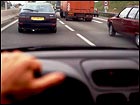
NEW YORK (CNN/Money) - The temperature's rising. You're putting those winter sweaters back in the bottom drawer. With summer just ahead, you may be already thinking about those two cheerful words: Road Trip.
But as much fun as it is to get on the open road, that's how miserable it can be to be stopped by mechanical trouble. So the first step toward keeping it fun is to make sure your car is in good shape.
Car owners need to do regular maintenance in all seasons, of course. But hot-weather driving poses special problems for the machinery in your car. Starting with the tires, here is a rundown of summer maintenance check points.
Tires
To start, make sure your tires don't need replacing. If you see the "wear bars" -- rubber strips that usually are darker than the tire-you definitely need new ones. If your tires are getting worn but you don't see the bars, stick a penny into the tire tread, Lincoln's head first. If the tread reaches to the top of his forehead or even less, consider buying new tires to make sure you are safe. If your tires are still in good shape, prevent unnecessary wear by rotating them whenever you change the oil -- recommended every 5,000 to 7,500 miles by most manufacturers.
New tires or old, keeping them at the right inflation level is crucial. Tires without enough air build up heat, which can lead to blowouts or tread separation. Tire safety experts say tires with just four to five pounds per square inch too little pressure can be dangerous. But in determining the proper pressure, don't use the numbers on the sidewall of the tire. Instead look for the manufacturer's recommended tire pressure for your particular vehicle. Those numbers -- often slightly different for front and rear tires -- will usually be posted on a small metal plaque on the driver's side door pillar, inside the glove compartment or -- in a few brands -- inside the gas cap door.
Belts and hoses
This is an important, but easy to overlook, checkpoint. "Cars used to require a fan belt change every year or so," notes David Van Sickle, automotive and consumer information director for the American Automobile Association. "Now the materials in belts and radiator hoses are so much better that people tend to forget about them." Van Sickle adds that problems with belts and hoses are the second-biggest cause of AAA roadside assistance calls after failed batteries. Have the belts and hoses checked during an oil change or other service visit. Or if you are between servicing, flex these belts and hoses yourself and look for any cracks, splits or leaks that might signal trouble ahead.
Batteries
The image you have of battery woes probably involves icy weather and that horrible slow grinding sound when the engine won't start. "But people should be aware that batteries deteriorate even faster in hot weather,' warns the AAA's Van Sickle. "So they want to be sure their batteries are in good shape before they start a summer trip." If your battery is more than three years old, have a professional check it with a measurement device that will flag a potential problem.
Brakes
Like tires, brakes are crucial to your family's safety. If you are servicing your vehicle, have the brakes checked -- especially when tires are being rotated. Or try this test to make sure you have enough stopping power: Find an empty parking lot or quiet road and accelerate to 50 mph. Then hit the brakes hard. If they are working well, you should stop within 100 feet, say safety specialists. If the brakes make unusual squealing or grinding noises when you hit them or if the steering wheel pulls to one side, those are danger signals.
If your car has an anti-lock braking system (ABS), as most recent models do, pay close attention to your dashboard indicators. When you start the engine, a light on the dash usually labeled ABS comes on as computerized diagnostics check out the system. If the light goes out after about two seconds, the system is in good working order. If the light stays on, you should have a mechanic check your brakes.
Seat belts
You want to be sure these lifesaving devices are working well. The belts should unreel smoothly when you pull them, and then retract snugly around you after you fasten the latch. If your belt is not fitting snugly, check the "retractor" -- a spool-like device near the floor. If debris is caught in there, it could be causing problems. On older cars, also look to make sure the belts are not frayed or torn.
If your vacation plans include towing a boat or trailer or carrying an especially heavy load of people and luggage, you may need to make extra adjustments. The specialists at online tire seller Tirerack.com say heavy loads can require adding up to five pounds per square inch to each tire. Owners' manuals for many vehicles discuss what to do to compensate for such heavy loads. If you are traveling in a high-riding sport utility vehicle or minivan, try to get it loaded without using a roof cargo carrier. Such carriers raise the center of gravity even further, increasing the chance of a rollover if something goes wrong. Taking all these maintenance steps increases your chances of a happy, safe trip. After all, notes AAA's Van Sickle: "Sitting alongside the Interstate with a ruptured radiator hose or other problem you might have avoided can really spoil a vacation."

|

